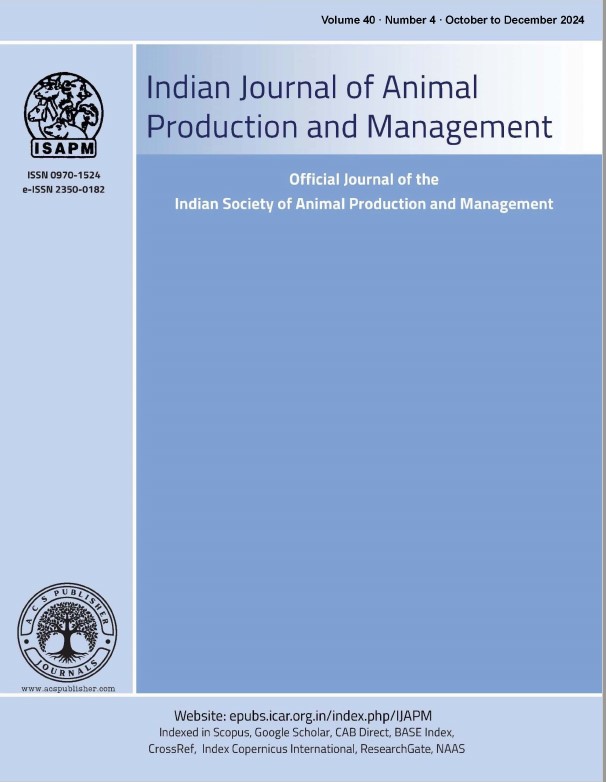Effect of dietary supplementation ofliquid distillery stillage on growth per formance of Rajasri chicks
DOI:
https://doi.org/10.48165/ijapm.2025.41.1.1Keywords:
Rajasri chicks, Liquid Distillery Stillage, hicks, Liquid Distillery Stillage,, Feed intake and Feed Conversion RatioAbstract
The present study was conducted at institutional poultry farm of Krishi Vigyan Kendra, Nandyal District, Andhra Pradesh, India to evaluate the effects of dietary liquid distillery stillage (LDS) supplementation on the growth performance of the Rajasri chicks. A total of 60 one-week-old Rajasri chicks were divided into three groups, and each group supplemented a different dietary treatment: T0 (basal diet without antibiotic), T1 (70% basal diet + 30% LDS), and T2 (50% basal diet + 50% LDS).The results indicated significant differences in growth among the dietary treatments. The highest average feed intake was observed in T2across all four weeks. Similarly, T2 showed the highest average body weight gain, suggesting better growth compared to T0 and T1. Moreover, T2 consistently exhibited the lowest FCR across all four weeks, indicating better feed efficiency compared to the other treatments. On the other hand, T1 showed intermediate performance in all three parameters, while T0 had the least favourable outcomes. From the experiment, it was concluded that, the supplementation of LDS in the diet of Rajasri chicks at 50% have resulted in improved feed intake, body weight gain, and feed efficiency, indicating enhanced growth performance. These findings underscore the significance of optimizing feed formulations to support better growth and productivity in poultry production systemsto achieve optimal growth and profitability in poultry farming.
References
Ahmed, A. A., Al-Mustafa, A. T., Al-Jaff, M. F., & Al-Abbady, H. J. (2020). Influence of using diets with different nutrient levels on performance, egg quality, and egg components of laying hens. Journal of Advanced Veterinary and Animal Research, 7(2), 205–212.
Amad, A. A., Männer, K., & Wendler, K. R. (2019). Effect of different dietary protein and energy concentrations on growth performance and carcass characteristics in male turkeys. Poultry Science, 98(3), 1429–1438.
Beyki, M., Jahanian, R., & Rezaei, M. (2016). Growth performance, relative growth rate and feed utilization of broiler chicks fed different levels of threonine, tryptophan and isoleucine. Animal Feed Science and Technology, 212, 60–66.
Devi, K. S., & Reddy, P. M. (2005). Genetic studies on certain economic traits in White Leghorn and crossbred chicken. Indian Journal of Poultry Science, 40, 56–58.
Gous, R. M., Morris, T. R., Iji, P. A., & Cadogan, D. J. (2016). Body and feather growth of broilers in response to diet dilution with wheat bran. British Poultry Science, 37(2), 275–285.
Hetland, H., Svihus, B., & Krogdahl, Å. (2003). Effects of oat hulls and wood shavings on digestion in broilers and layers fed diets based on whole or ground wheat. British Poultry Science, 44(2), 275–282.
Huige, N. (2006). Brewery by-products and effluents. In F. G. Priest & G. G. Stewart (Eds.), Handbook of brewing (2nd ed., pp. 656–707). Boca Raton, FL: Taylor & Francis Group.
Kerby, C., & Vriesekoop, F. (2017). An overview of the utilisation of brewery by-products as generated by British craft breweries. Beverages, 3(24).
Khalique, A., Khan, S., Hassan, Z., Ahmed, S., Saleem, S., & Mehmood, S. (2019). Influence of different feed forms on the growth performance of broiler chickens. Journal of Animal Physiology and Animal Nutrition, 103(2), 512–519.
Lynch, K. M., Steffen, E. J., & Arendt, E. K. (2016). Breweries spent grain: A review with an emphasis on food and health. Journal of the Institute of Brewing, 122, 553–568.
Mussatto, S. I., & Roberto, I. C. (2005). Acid hydrolysis and fermentation of brewers spent grain to produce xylitol. Journal of the Science of Food and Agriculture, 85, 2453–2460.
Snedecor, G. W., & Cochran, W. G. (1989). Statistical methods (8th ed.). Ames, IA: Iowa State University Press.
Vieira, S. L., & Moran, E. T. (2017). Effects of dietary electrolyte balance on broiler live performance and carcass yield. Journal of Applied Poultry Research, 26(2), 334–343.

